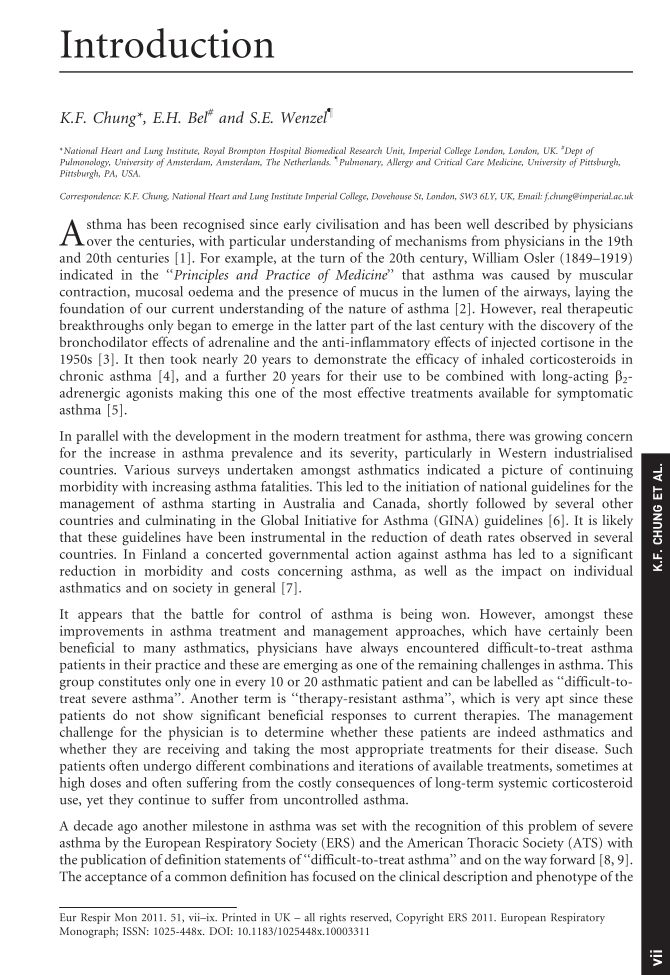Introduction K.F. Chung*, E.H. Bel# and S.E. Wenzel" *National Heart and Lung Institute, Royal Brompton Hospital Biomedical Research Unit, Imperial College London, London, UK. # Dept of Pulmonology, University of Amsterdam, Amsterdam, The Netherlands. " Pulmonary, Allergy and Critical Care Medicine, University of Pittsburgh, Pittsburgh, PA, USA. Correspondence: K.F. Chung, National Heart and Lung Institute Imperial College, Dovehouse St, London, SW3 6LY, UK, Email: f.chung@imperial.ac.uk A sthma has been recognised since early civilisation and has been well described by physicians over the centuries, with particular understanding of mechanisms from physicians in the 19th and 20th centuries [1]. For example, at the turn of the 20th century, William Osler (1849–1919) indicated in the ‘‘Principles and Practice of Medicine’’ that asthma was caused by muscular contraction, mucosal oedema and the presence of mucus in the lumen of the airways, laying the foundation of our current understanding of the nature of asthma [2]. However, real therapeutic breakthroughs only began to emerge in the latter part of the last century with the discovery of the bronchodilator effects of adrenaline and the anti-inflammatory effects of injected cortisone in the 1950s [3]. It then took nearly 20 years to demonstrate the efficacy of inhaled corticosteroids in chronic asthma [4], and a further 20 years for their use to be combined with long-acting b2- adrenergic agonists making this one of the most effective treatments available for symptomatic asthma [5]. In parallel with the development in the modern treatment for asthma, there was growing concern for the increase in asthma prevalence and its severity, particularly in Western industrialised countries. Various surveys undertaken amongst asthmatics indicated a picture of continuing morbidity with increasing asthma fatalities. This led to the initiation of national guidelines for the management of asthma starting in Australia and Canada, shortly followed by several other countries and culminating in the Global Initiative for Asthma (GINA) guidelines [6]. It is likely that these guidelines have been instrumental in the reduction of death rates observed in several countries. In Finland a concerted governmental action against asthma has led to a significant reduction in morbidity and costs concerning asthma, as well as the impact on individual asthmatics and on society in general [7]. It appears that the battle for control of asthma is being won. However, amongst these improvements in asthma treatment and management approaches, which have certainly been beneficial to many asthmatics, physicians have always encountered difficult-to-treat asthma patients in their practice and these are emerging as one of the remaining challenges in asthma. This group constitutes only one in every 10 or 20 asthmatic patient and can be labelled as ‘‘difficult-to- treat severe asthma’’. Another term is ‘‘therapy-resistant asthma’’, which is very apt since these patients do not show significant beneficial responses to current therapies. The management challenge for the physician is to determine whether these patients are indeed asthmatics and whether they are receiving and taking the most appropriate treatments for their disease. Such patients often undergo different combinations and iterations of available treatments, sometimes at high doses and often suffering from the costly consequences of long-term systemic corticosteroid use, yet they continue to suffer from uncontrolled asthma. A decade ago another milestone in asthma was set with the recognition of this problem of severe asthma by the European Respiratory Society (ERS) and the American Thoracic Society (ATS) with the publication of definition statements of ‘‘difficult-to-treat asthma’’ and on the way forward [8, 9]. The acceptance of a common definition has focused on the clinical description and phenotype of the Eur Respir Mon 2011. 51, vii–ix. Printed in UK – all rights reserved, Copyright ERS 2011. European Respiratory Monograph ISSN: 1025-448x. DOI: 10.1183/1025448x.10003311 vii K.F. CHUNG ET AL.
